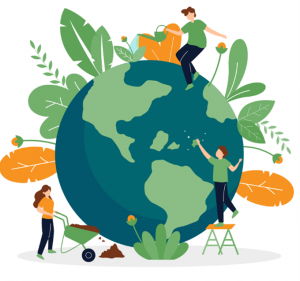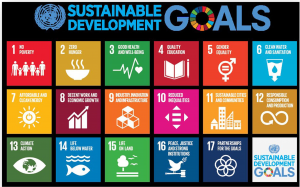Recently, Earth Day celebrated its 52nd anniversary on April 22nd, 2022, whereas World Environment Day is celebrated on June 5th each year. Many often think it’s a duplicate niche holiday but each has its own separate origin and focus.
Firstly, Earth Day originated in 1970 and then a few years later in 1972, World Environment Day began. In June 1972, the United Nations (UN) gathered a group of politicians in Sweden to address the growing challenges of preserving and protecting the environment. Later that year, the UN General Assembly responded by forming the United Nations Environmental Programme (UNEP) and designated June 5th as World Environment Day with the goal of raising awareness and encouraging governments to commit towards the environment around important concerns such as global warming, deforestation, and depletion of the ozone layer.
“Only One Earth” is the campaign slogan for World Environment Day, with the focus on “Living Sustainably in Harmony with Nature”. Protecting our biodiversity is an activity that is essential for the health of our planet since all living things are interconnected. For example, deforestation doesn’t just impact the oxygen level in the atmosphere but displaces species from their habitats. Similarly, plastic pollution doesn’t just destroy marine life, but impacts everything from the food chain to the ozone layer. This year’s campaign highlights the need to reset the balance with nature through transformative changes in how we eat, live, work and move around.

Importance of World Environment Day
The core focus in the creation of this event is centered on sustainable development, with the theme itself emphasizing that time is running out for our planet. World Environment Day 2022 comes at a crucial time where we are in a decade of action to deliver and meet the Sustainability Development Goals (SDG’s). The United Nations developed the SDG’s framework in 2015 that outlines seventeen (17) sustainability goals and environmental related targets (refer to Figure 1). These goals are designed to end poverty, famine, gender discrimination and protect the planet. While countries continue to strive to meet these goals as part of the 2030 agenda, the creativity, technology, and financial resources from all of society is necessary to achieve the SDG’s.
The World Environment Day campaign helps raise global awareness on climate change, biodiversity and nature loss, pollution, and waste. It highlights the need for action by governments and business organizations to leverage the power and finance that is required for placing the policies and infrastructures towards sustainable living. Aside from governments, youth and civil society must play a key role in advocating for change.

Figure 1: Summary of the Sustainable Development Goals (SDG’s) (The Sustainable Development Goals, n.d.)
Environmental Issues
Our planet is currently facing several issues such as climate change, loss of biodiversity, pollution, and improper waste management.
- Climate change– The planet is undergoing a climate crisis due to the release of carbon emissions which is causing higher ambient temperatures resulting in loss of habitat, failure of humans and nature to adapt and a shift in seasons.
- Loss of biodiversity- Habitats and ecosystems from rainforests to wetlands continue to be lost and threatened by human activities such as human expansion, deforestation, and farming. Other activities such as illegal wildlife trade and logging are diminishing populations of rare plants and animals.
- Pollution- This is mainly attributed by the burning of fossil fuels, nutrients from farming, sediment from soil erosion and discarded plastic waste polluting both fresh and coastal waters.
The crisis that we face today are a result of our poor use of the planet’s resources and improper waste disposal. Our demand for resources exceeds the Earth’s capacity to provide them by an estimated 75 per cent. According to (United Nations Environment Programme, 2022, p. 5), people significantly impact nearly three-quarters of land and two-thirds of the oceans; and greenhouse gas emissions must be halved in the next eight years to keep global warming below 1.5°C. There is new evidence that households are associated with two-thirds of all greenhouse gas emissions, and the latest Intergovernmental Panel on Climate Change (IPCC) report shows that sustainable lifestyles and behaviors could reduce our emissions by 40–70 per cent by 2050.
What can we as individuals do to protect the planet?
We must make a conservative effort to heal and protect our planet as well as continue to advance to a more sustainable future. As citizens, workers, students, consumers or in any other roles, our individual decisions shape how our societies impact the environment. We must also transform our personal lives to a more sustainable way of living. As individuals we can support faster and press for more far-reaching environmental change from larger entities like governments and businesses.
Change is difficult but no matter how small it is, even just one simple change can make a positive impact. Here are some actions you can take:
- Eliminate the use of single-use plastics- Plastic pollution is a major source of harm to humans and marine life around the world and it is a major contributor to climate change and global warming. To reduce plastic waste, it starts with individual action. Here are some simple ways to reduce your plastic usage:
- Carry Reusable Shopping Bags to groceries and markets
- Avoid plastic bottled water
- Steer clear of plastic straws
- Shop at a farmer’s market
- Recycle and Reuse plastic containers at work and home
- Compost food waste
- Advocate for change- Support leaders of governments with clear commitments and a proven track record for handling environmental emergencies including climate change, biodiversity loss and pollution.
- Start a discussion- Get involved in a petition, debate or call a demonstration to encourage your government and business organizations to transform transportation, restore and protect nature and clean up our resources.
- Get involved- Campaign for sustainable urban planning including the restoration of contaminated sites, inclusion of green spaces in new housing developments and green public transport networks. Join a local organization that promotes sustainability and restores nature by campaigning for systemic change.
- Spread knowledge- Conduct research and gather information into the science around an issue that concerns you and spread your knowledge with friends, family, and your wider community. Engage in public discussions including on social media.
- Conserve energy- Turn off lights and electronics when not in use, use appliances with high energy efficiency ratings. This will reduce emissions and in return save you money.
- Change eating habits- Reduce foods that need more natural resources especially water such as meat which uses more water than plants. Also, refrain from fruits and vegetables that are imported over long distances.
- Reduce food wastage- Compost food scraps instead of throwing it away. Also, store food carefully to stop it from spoiling.
- Grow your own food- Growing your own food not only saves you money but reduces the transport, packaging, and food wastage.
- Invest in a greener vehicle- Personal transport is a huge contributor to the climate crisis, cars that use petrol and diesel are responsible for most of the transport sector’s greenhouse gas emissions. Using an electric vehicle and cleaner fuels are more environmentally friendly.
- Keep active- Do more walking or cycling to reduce carbon emissions and road congestion. The more people that use cycle lanes and sidewalks, the more governments will need to re-design infrastructure to focus less on cars.
References
- United Nations Environment Programme. (2022). Practical Guide. World Environment Day. https://www.worldenvironmentday.global/get-involved/practical-guide
- Cahn, L. (2021, July 21). World Environment Day vs. Earth Day: What’s the Difference? Reader’s Digest. https://www.rd.com/article/world-environment-day-vs-earth-day/
- The evidence is clear: the time for action is now. We can halve emissions by 2030. (2022, April 4). IPCC. https://www.ipcc.ch/2022/04/04/ipcc-ar6-wgiii-pressrelease/
- Angeli, S. (2022, April 23). World Environment Day 2022: #OnlyOneEarth. Ecobnb. https://ecobnb.com/blog/2022/05/world-environment-day-2022/

1 Comment.
Why separate environmental protection day, and environment day